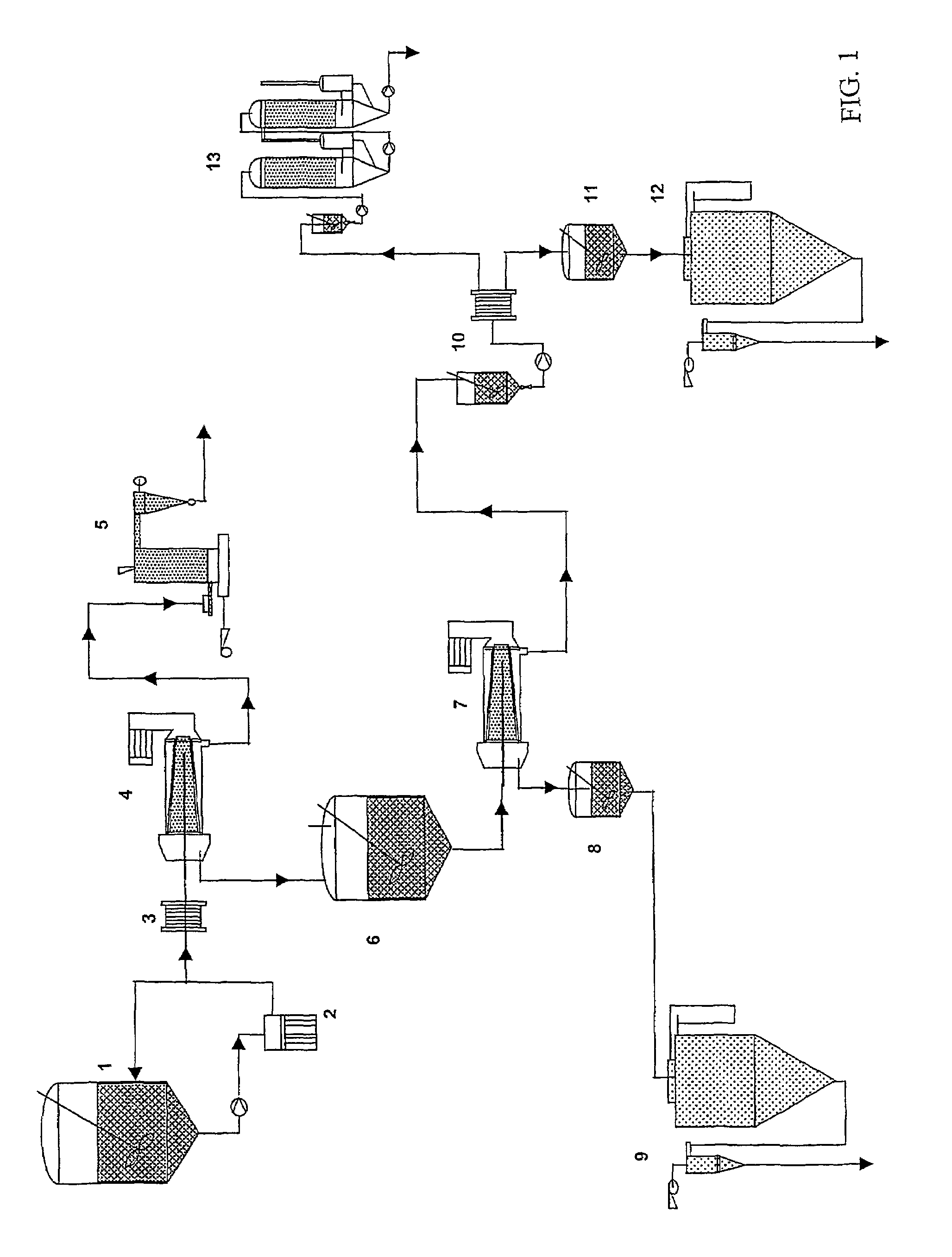Process for the fractionation of cereal brans
a technology of cereal bran and fractionation process, which is applied in the field of process for the fractionation of cereal bran, can solve the problems of high cost, high cost, and high cost of processing, and achieves the effects of reducing the cost of processing, and improving the quality of cereal bran
- Summary
- Abstract
- Description
- Claims
- Application Information
AI Technical Summary
Benefits of technology
Problems solved by technology
Method used
Image
Examples
example 1
[0084]Wheat bran produced from short milling (SMB) and conventional milling (CMB) processes were used in this trial. Bran sample of 25 kg was transferred to a mixing tank and sequentially hydrolysed at temperatures varying from 70° C. at the first stage with α-amylase to 60° C. in the second stage with amyloglucosidase for a total hydrolysis time of 3 h. During this period the reaction mixture was intermittently wet milled to increase in surface area and dispersion of soluble components. The pH of the reaction mixture was set at neutral initially and then decreased down to 4.5 with acetic acid in the second stage. In addition of maximising the enzymatic activity the acidic pH allowed partial solubilization of the phytates present in the bran.
[0085]At the end of the enzymatic hydrolysis and wet milling step the enzymes contained in the reaction mixture were inactivated by wet heating through a heat exchange and quickly cooled down to room temperature.
[0086]The hydrolysed bran solutio...
example 2
[0091]Wheat bran produced from conventional milling was subjected to enzymatic treatment and wet milling as described in Example 1. The hydrolysed bran was fractionated using a two-phase decanter into an insoluble (combined fibre and aleurone) and a soluble fraction.
[0092]The soluble fraction was fed into a separator for fractionation using centrifugal forces thus producing two phases. The germ-rich phase was washed with water and fed again to the separator to remove the excess solubles. The resulting protein fraction was kept as such or mixed with evaporated liquid whey on a 1:1 ratio (dry matter basis).
[0093]The endosperm-rich wheat fraction, which contained high levels of sugar, was processed in to an ultrafilter in order to separate low molecular weight sugars and a protein fraction.
[0094]All soluble protein fractions, i.e. germ and endosperm-rich phases and the mixtures with whey, were spray dried separately. The sugar fraction was concentrated by vacuum evaporation at mild tem...
example 3
[0098]Previous examples illustrate the use of starch-hydrolysing enzymes and wet milling followed by various separation steps in order to yield both protein, sugar and fibre fractions, the latter still containing substantially high amounts of aleurone proteins. It could be of interest for same applications to separate, at least partly, the aleurone proteins from the bran pericarp (fibre) and recover such proteins in the same fraction as the endosperm-rich fraction for instance.
[0099]A trial was set up in the same way as described in EXAMPLE 2, except that a cocktail of polysaccharidases containing both high cellulase and xylanase activities was added together with the amyloglucosidases, and let to work for 3 h. Temperature and pH conditions were kept unchanged. The resulting reaction mixture was further treated exactly as described in EXAMPLE 2.
[0100]The inclusion of polysaccharidase during the hydrolysis step had a positive effect with regards to aleurone protein extraction and pro...
PUM
| Property | Measurement | Unit |
|---|---|---|
| temperature | aaaaa | aaaaa |
| pH | aaaaa | aaaaa |
| temperature | aaaaa | aaaaa |
Abstract
Description
Claims
Application Information
 Login to View More
Login to View More - R&D
- Intellectual Property
- Life Sciences
- Materials
- Tech Scout
- Unparalleled Data Quality
- Higher Quality Content
- 60% Fewer Hallucinations
Browse by: Latest US Patents, China's latest patents, Technical Efficacy Thesaurus, Application Domain, Technology Topic, Popular Technical Reports.
© 2025 PatSnap. All rights reserved.Legal|Privacy policy|Modern Slavery Act Transparency Statement|Sitemap|About US| Contact US: help@patsnap.com


